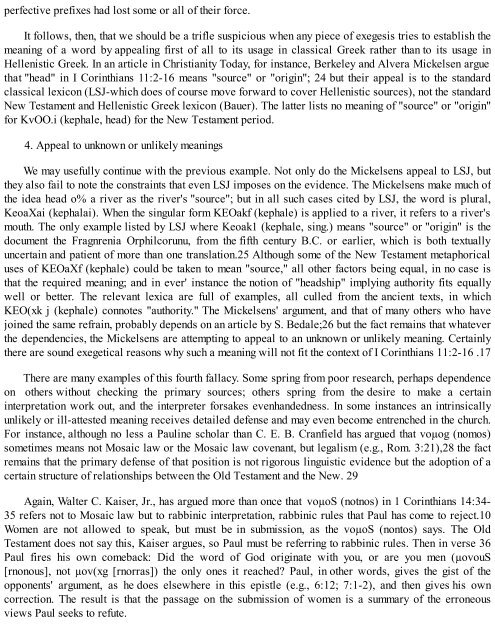Exegetical Fallacies - D. A. Carson
Exegetical Fallacies - D. A. Carson
Exegetical Fallacies - D. A. Carson
You also want an ePaper? Increase the reach of your titles
YUMPU automatically turns print PDFs into web optimized ePapers that Google loves.
perfective prefixes had lost some or all of their force.<br />
It follows, then, that we should be a trifle suspicious when any piece of exegesis tries to establish the<br />
meaning of a word by appealing first of all to its usage in classical Greek rather than to its usage in<br />
Hellenistic Greek. In an article in Christianity Today, for instance, Berkeley and Alvera Mickelsen argue<br />
that "head" in I Corinthians 11:2-16 means "source" or "origin"; 24 but their appeal is to the standard<br />
classical lexicon (LSJ-which does of course move forward to cover Hellenistic sources), not the standard<br />
New Testament and Hellenistic Greek lexicon (Bauer). The latter lists no meaning of "source" or "origin"<br />
for KvOO.i (kephale, head) for the New Testament period.<br />
4. Appeal to unknown or unlikely meanings<br />
We may usefully continue with the previous example. Not only do the Mickelsens appeal to LSJ, but<br />
they also fail to note the constraints that even LSJ imposes on the evidence. The Mickelsens make much of<br />
the idea head o% a river as the river's "source"; but in all such cases cited by LSJ, the word is plural,<br />
KeoaXai (kephalai). When the singular form KEOakf (kephale) is applied to a river, it refers to a river's<br />
mouth. The only example listed by LSJ where Keoak1 (kephale, sing.) means "source" or "origin" is the<br />
document the Fragnrenia Orphilcorunu, from the fifth century B.C. or earlier, which is both textually<br />
uncertain and patient of more than one translation.25 Although some of the New Testament metaphorical<br />
uses of KEOaXf (kephale) could be taken to mean "source," all other factors being equal, in no case is<br />
that the required meaning; and in ever' instance the notion of "headship" implying authority fits equally<br />
well or better. The relevant lexica are full of examples, all culled from the ancient texts, in which<br />
KEO(xk j (kephale) connotes "authority." The Mickelsens' argument, and that of many others who have<br />
joined the same refrain, probably depends on an article by S. Bedale;26 but the fact remains that whatever<br />
the dependencies, the Mickelsens are attempting to appeal to an unknown or unlikely meaning. Certainly<br />
there are sound exegetical reasons why such a meaning will not fit the context of I Corinthians 11:2-16 .17<br />
There are many examples of this fourth fallacy. Some spring from poor research, perhaps dependence<br />
on others without checking the primary sources; others spring from the desire to make a certain<br />
interpretation work out, and the interpreter forsakes evenhandedness. In some instances an intrinsically<br />
unlikely or ill-attested meaning receives detailed defense and may even become entrenched in the church.<br />
For instance, although no less a Pauline scholar than C. E. B. Cranfield has argued that voµog (nomos)<br />
sometimes means not Mosaic law or the Mosaic law covenant, but legalism (e.g., Rom. 3:21),28 the fact<br />
remains that the primary defense of that position is not rigorous linguistic evidence but the adoption of a<br />
certain structure of relationships between the Old Testament and the New. 29<br />
Again, Walter C. Kaiser, Jr., has argued more than once that voµoS (notnos) in 1 Corinthians 14:34-<br />
35 refers not to Mosaic law but to rabbinic interpretation, rabbinic rules that Paul has come to reject.10<br />
Women are not allowed to speak, but must be in submission, as the voµoS (nontos) says. The Old<br />
Testament does not say this, Kaiser argues, so Paul must be referring to rabbinic rules. Then in verse 36<br />
Paul fires his own comeback: Did the word of God originate with you, or are you men (µovouS<br />
[rnonous], not µov(xg [rnorras]) the only ones it reached? Paul, in other words, gives the gist of the<br />
opponents' argument, as he does elsewhere in this epistle (e.g., 6:12; 7:1-2), and then gives his own<br />
correction. The result is that the passage on the submission of women is a summary of the erroneous<br />
views Paul seeks to refute.



